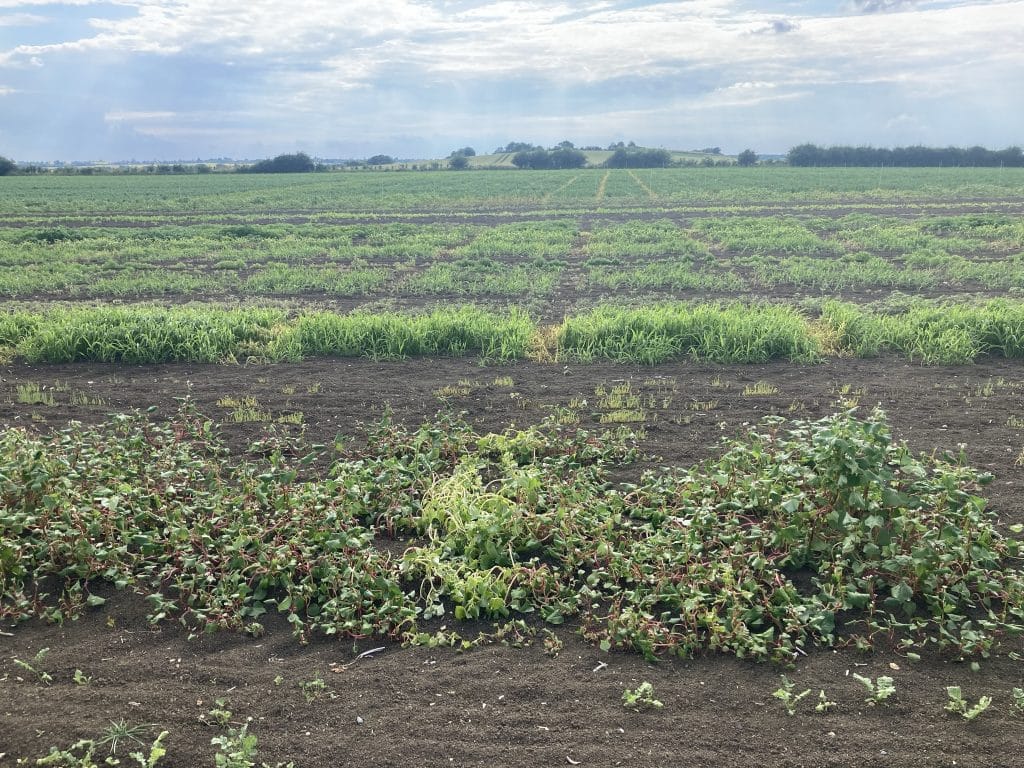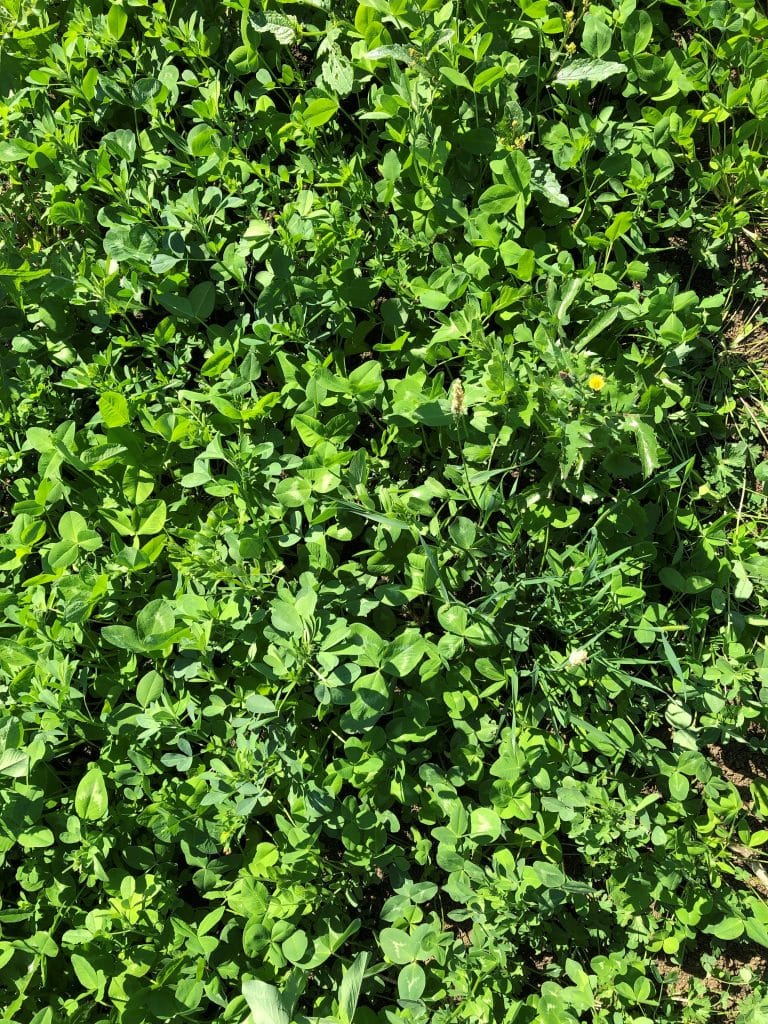Environmental options to bridge the BPS gap – Arable Farming
A new trials site dedicated to testing out some of the stewardship options that will be central to future support within ELMs recently opened its doors to growers ...
Paul Spackman finds out more.
The ongoing reduction of Basic Payment Scheme (BPS) support through to 2027 threatens to leave a gaping hole in the finances of many farm businesses. But it will be possible to bridge much of this gap by accessing the range of environmental payments available now and over coming years.
That was the clear message to growers attending the Hutchinsons Environmental trials demonstration near Warboys, Cambridgeshire, where a range of options is being examined in a commercial farm situation.
The site is hosted on the 180-hectare family farm run by P.F. England and Son, which grows mainly cereals and sugar beet on Grade 1 fenland and heavy clay-based soils.
Growers attending the open day on September 16 got to see the many traditional and exotic species which make up different stewardship mixes, heard how to establish them successfully and discussed the benefits they could deliver to biodiversity and soil health.
Hutchinsons environmental specialist Hannah Joy said: “We know BPS payments will be 50% lower by 2024 and will be gone completely by 2027, so it is crucial growers find ways of bridging this gap.
Although the Environmental Land Management scheme (ELMs) will not be launched until 2024, she said there were good funding opportunities within the existing Countryside Stewardship (CS) scheme, which could be rolled over into ELMs in the future.
Next spring would also see the launch of two Sustainable Farming Incentive soils standards which will be a key part of ELMs. These promise to open up other potential sources of income to anyone currently claiming BPS, and could be paid on top of CS.
However, entering into any stewardship agreement has to be well planned and not seen as a ‘tick-box’ exercise to claim payments. This would ensure options deliver the maximum benefit to individual farm businesses, she added.
Colleague Matt England, whose family farm hosts the trials site, said: “Ultimately, if you’re going to be putting a percentage of your farm down to any kind of stewardship mixes now and in the future, then you have to select the most appropriate options for your situation and manage them well to get the most out.”
The Warboys site includes spring-drilled plots of 16 different species sown as straights, showcasing the characteristics and growth habits of exotic species, such as sorghum, reed millet, camelina and quinoa, alongside more familiar names, such as kale, stubble turnip and sunflower.
A range of seed mixes has also been established, including the two-year legume option (with and without grass) and other flower/nectar-rich mixes, which are already attracting considerable interest among farmers in existing stewardship schemes, the ELMs pilot and regenerative agriculture.
When evaluating the choices available, Mr England advised farmers to be clear on what they wanted from any stewardship mix (for example, soil improvement, fertility building, winter bird food and grazing potential) and consider factors such as soil type, local weed pressure and whether options would be rotational or remain in the same location.
A basic seed mix for the Mid Tier AB8 option (flower-rich margins and plots), for example, was based on a limited number of species which typically lasted four to five years, so may suit more temporary positions, he said.
In contrast, where growers planned to keep stewardship in the same place for a number of years, it would be preferable to select mixes containing more true perennial species to maintain flowers throughout the life of that option.
Mr England said the potential for grazing stewardship or taking a cut of silage was important for arable farms with livestock and options such as the GS4 legume and herb-rich sward provided a good choice.
Five-week gap
He said: “It can be grazed throughout the year, although you have to leave a five-week gap at some point between May 1 and July 31 for plants to flower.”
For those without livestock, the AB15 two-year legume was a good alternative for bringing in a range of herbs, legumes and grass for soil conditioning benefits. From 2021, a grass-free mix was also available, he said.
“In the past, some growers have used the AB15 mix to help suppress black-grass, but that is not necessarily the best option, as black-grass can still grow and set seed within it.”
Get rewarded for improving soils
Next spring’s launch of the first ‘standards’ within the new Sustainable Farming Incentive marks another good opportunity for growers to be rewarded for adopting measures which will improve soil health (see table).
But as with the adoption of stewardship schemes, it must not be seen as a tick-box exercise, Hutchinsons farm business consultant Will Foyle said.
“Yes, there are good payments available for meeting the different levels of ambition, but it shouldn’t be a case of just doing the minimum to get a payment. Use this as an opportunity to help improve your soils and make them work better to raise productivity across the farm business.”
For example, rather than just conducting a basic soil assessment of structure, biology and organic matter, it may be a good opportunity to conduct detailed analysis of all the main soil parameters, as there could be areas restricting productivity.
At the Warboys site, for example, detailed soil analysis revealed compaction on a turning headland that had been exacerbated by high soil magnesium levels. This is being rectified with a tailored multi-species cover crop mix and planned applications of gypsum, an effective source of water-soluble calcium which displaces magnesium and improves physical soil properties.
Accurately recording results would be vital for farmers to demonstrate compliance with the new soils standards and Mr Foyle noted that Hutchinsons was adding further functionality to its Omnia precision farming platform to help growers do this.
Arable and horticultural soils standard
Source: Defra
| Level | Payment per hectare | Actions |
|---|---|---|
| Introductory | £26 | Complete a basic soil assessment Establish green cover over winter (5% of area) Increase soil organic matter (10% of area) |
| Intermediate | £41 | Complete a basic soil assessment Establish green cover over winter (10% of area) Increase soil organic matter (15% of area) Use no, low or min tillage techniques (25% of area) |
| Advanced | £60 | Complete a basic soil assessment/create a soil management plan Establish green cover over winter (15% of area) Increase soil organic matter (20% of area) Use no, low or min tillage techniques (25% of area) |
Herbicide options
Given the importance of weed control when establishing stewardship mixes, Hutchinsons has included a herbicide trial featuring 19 pre ems, post-ems and combinations of both to see what chemistry works on different species.
Farmacy agronomist Jim Woodward said: “Effectively it’s a weed screen to investigate the crop safety of chemistry options when establishing mixes containing multiple species, and see what products will work when it is time to spray then off. This is just the first step. We plan to repeat the trial and, once we’ve identified what works, we can look at the legality of what growers can do through the use of extension of authorisation for minor use.”
Establishment is key
Establishing stewardship mixes well and at the right time is fundamental to ensuring they deliver maximum benefit. Mr England highlighted three key areas to focus on:
Weeds are one of the biggest threats to the establishment of stewardship mixes and their long-term performance. Keeping mixes weed-free promotes better biodiversity by allowing flowering and seed-producing species to thrive, rather than having them outcompeted by weeds.
Annual weeds can be controlled relatively easily with regular cutting in grass mixes, especially in the first year, but perennial weeds, notably creeping thistle and docks, could be more problematic.
Taking time to control weeds with a stale seedbed pre-drilling is a very effective way of reducing the initial weed burden, but in high pressure situations it could be necessary to fallow areas for longer to control problematic weeds.
This was illustrated at Warboys, with two plots of winter bird cover, one sown on May 5, the other on May 31. The earlier- sown plot had more time to grow, but was under higher weed pressure as there was less time to control weeds before drilling.
Many species within stewardship mixes have very small seeds, so a fine, firm seedbed is crucial for maximising seed-to-soil contact and promoting good germination. Seed must not be sown too deep, otherwise it is unlikely to germinate.
Having sufficiently warm and moist soil for seeds to germinate and establish quickly to outcompete weeds is fundamental to the success of any stewardship mix.
Resisting the urge to get on with drilling in spring can be difficult, but warm season species used in wild bird mixes, such as millet, require soil temperature to be at least 10degC, but ideally 15degC, for rapid emergence and establishment.
Later drilling usually means warmer soils, and also gives plenty of opportunity to achieve a stale seedbed, but it can be dry. Drilling into moisture is essential, so it is always best to wait for rain and then drill, rather than putting seed into bone dry seedbeds and hoping for rain.


